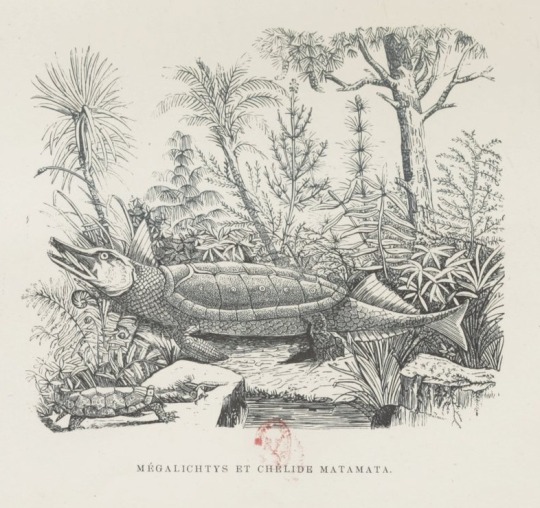#megalichthys
Explore tagged Tumblr posts
Text

"Megalichtys [sic] et chelide Matamata" [Megalichthys and Matamata turtle] from Paris avant les hommes [Paris Before Man] written and illustrated by Pierre Boitard
Published posthumously as a novel with updated illustrations in 1861, first published in Musée des Familles – Lectures du Soir, 1836-1837
https://gallica.bnf.fr/ark:/12148/bpt6k6416941b/f67.item
69 notes
·
View notes
Note
What's up with the depictions of Megalichthys that give it a turtle shell?
This repost by @a-book-of-creatures includes a translation of the relevant text and it seems Megalichthys was considered a missing link style half fish-half reptile/turtle, so I guess the shell was conjecture based on that
14 notes
·
View notes
Text

Dictionnaire populaire illustré d'histoire, de géographie, de biographie, de technologie, de mythologie, d'antiquités, des beaux-arts et de littérature, 1862, vol. 1, p. 144
https://gallica.bnf.fr/ark:/12148/bpt6k2002513/f144.item
7 notes
·
View notes
Text
"Among the most singular beings that made the transition from gilled vertebrates to those with lungs, here is the most extraordinary: it is the megalichthys that you see swimming in the waves that bathe this shore; it's a sort of monster that is half fish and half reptile, or, if you prefer, half pike and half turtle. The head of those animals was very similar to that of the pike; they could breathe in water through their gills, and breathe on land using a pulmonary apparatus similar to that of reptiles. They dragged themselves along the mud at the bottom of the waters using their turtle feet; they swam in the middle of the water with their fish's fins and powerful sauroid tail; and from time to time, either to pursue prey, or to enjoy the gentle influence of the sun, they emerged from the water and took a pleasure stroll on the sandy shore of the bank". "What!" I cried out, "animals that live both in the water and on land! You resurrect there the old prejudice of our fathers who believed in amphibians, a prejudice that has been vigorously refuted by our modern naturalists. Open the books of the latter, and you will see that a vertebrate animal can breathe only by gills that decompose water to seize its oxygen, like fish, and those can only exist in their element, which is water; or through lungs that decompose air, and those can only live in air. They amusingly refer to this phenomenon as a law; therefore, according to them and their law, an amphibian is an impossible being". "But what if the megalichthys had both gills and lungs?" "Impossible, I tell you! How would you prove it?" "As I shall, by analogy. Japan possesses two or three animals that have this double faculty; the swamps of America have two; but, without going that far, let us find an example near to us. There exists in the subterranean waters of Carniola a little animal that we call the olm (proteus anguinus, Cuv.) [...] [description of the olm follows, it has lungs and gills] The siren (siren lacertina, Lin.), that lives in the Carolina swamps... [...] [description of the siren follows] But why would you go that far to find examples that you have before you every day. Have you never noticed that reptiles in the class of the amphibians: toads, frogs, salamanders, newts, etc. spend all their infancy in water breathing with gills, then, at a certain time in their existence, they stop being fish to become terrestrial animals breathing with gills".
Translation note: there are two words in French that refer to what are called amphibians in English. The word used in "the class of the amphibians" is batracien, while amphibien is used in all the other places to refer to, for lack a better term, a "missing link". So no, he's not denying that frogs and salamanders exist!

"Megalichtys [sic] et chelide Matamata" [Megalichthys and Matamata turtle] from Paris avant les hommes [Paris Before Man] by Pierre Boitard
Published posthumously as a novel with updated illustrations in 1861, first published in Musée des Familles – Lectures du Soir, 1836-1837
https://gallica.bnf.fr/ark:/12148/bpt6k6416941b/f67.item
69 notes
·
View notes